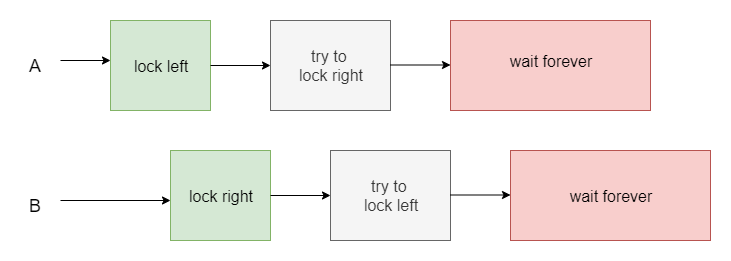Java - Thread Deadlock 死鎖
死鎖
【Java并发编程实战】頁205:
當一個線程永遠佔有一個鎖,而其他線程嘗試去獲得這個鎖,那麼它們將永遠被阻塞。
Deadlock (The Java™ Tutorials > Essential Classes > Concurrency)
Deadlock describe a situation where two or more threads are blocked forever, waiting for each other.
與許多其他的並發危險相同,死鎖很少能被立即發現。一個類如果有發生死鎖的潛在可能並不意味著死鎖每次都將發生,它只發生在該發生的時候。 當死鎖出現的時候,往往是遇到了最不幸的時候————在高負載之下。
各種死鎖
鎖順序死鎖
鎖順序死鎖(Lock-ordering deadlocks)原因:兩個線程試圖通過不同的順序獲得多個相同的鎖。如果請求鎖的順序相同,就不會出現循環的鎖依賴對象,也就不會產生死鎖了。
例如:若能夠保證同時請求鎖L和鎖M的每一個線程,都是按照從L到M的順序,那麼就不會發生死鎖了。
DeadLock Example:
public class LeftRightDeadlock {
private final Object left = new Object();
private final Object right = new Object();
public void leftRight() {
synchronized (left) {
synchronized (right) {
// doSth();
}
}
}
public void rightLeft() {
synchronized (right) {
synchronized (left) {
// doSth();
}
}
}
}
- 線程A調用
leftRight()方法,得到left鎖 - 同時線程B調用
rightLeft()方法,得到right鎖 - 線程A和線程B都繼續執行:
- 此時線程A需要
right鎖才能繼續往下執行 - 此時線程B需要
left鎖才能繼續往下執行
- 此時線程A需要
- 但是:
- 線程A的
left鎖並沒有得到釋放 - 線程B的
right鎖也沒有釋放
- 線程A的
- 所以他們都只能等待,而這種等待是無期限的 -> 永久等待 -> 死鎖

動態的鎖順序死鎖
動態的鎖順序死鎖(Dynamic lock order deadlocks)
有一個需求:把資金從一個賬戶轉入另一個賬戶。在執行轉賬前要獲得Account對象的鎖,確保操作是原子性,以及保護業務邏輯(例如賬戶餘額不能為負數)。
class DynamicLockOrderDeadlocks {
public void transferMoney(Account fromAccount, Account toAccount, DollarAmount amount) throws InsufficientFundsException {
synchronized (fromAccount) {
synchronized (toAccount) {
if (fromAccount.getBalance().compareTo(amount) < 0) throw new InsufficientFundsException();
else {
fromAccount.debit(amount);
toAccount.credit(amount);
}
}
}
}
}
事實上,上鎖的順序取決於傳遞給transferMoney的參數順序,這個參數的順序實際上又取決於外部輸入的順序。
- 如果兩個線程同時調用
transferMoney - 線程A:從
X向Y轉賬 - 線程B:從
Y向X轉賬 - 那麼就會發生死鎖。
A: transferMoney(myAccount, yourAccount, 10);
B: transferMoney(yourAccount, myAccount, 20);
協作對象間的死鎖
Deadlocks between cooperating objects:
import net.jcip.annotations.GuardedBy;
import java.util.HashSet;
import java.util.Set;
public class CooperatingDeadlock {
// Warning: deadlock-prone!
class Taxi {
@GuardedBy("this")
private Point location, destination;
private final Dispatcher dispatcher;
public Taxi(Dispatcher dispatcher) {
this.dispatcher = dispatcher;
}
public synchronized Point getLocation() {
return location;
}
// setLocation 需要Taxi内置锁
public synchronized void setLocation(Point location) {
this.location = location;
if (location.equals(destination))
// 调用notifyAvailable()需要Dispatcher内置锁
dispatcher.notifyAvailable(this);
}
public synchronized Point getDestination() {
return destination;
}
public synchronized void setDestination(Point destination) {
this.destination = destination;
}
}
class Dispatcher {
@GuardedBy("this")
private final Set<Taxi> taxis;
@GuardedBy("this")
private final Set<Taxi> availableTaxis;
public Dispatcher() {
taxis = new HashSet<Taxi>();
availableTaxis = new HashSet<Taxi>();
}
public synchronized void notifyAvailable(Taxi taxi) {
availableTaxis.add(taxi);
}
// 调用getImage()需要Dispatcher内置锁
public synchronized Image getImage() {
Image image = new Image();
for (Taxi t : taxis)
// 调用getLocation()需要Taxi内置锁
image.drawMarker(t.getLocation());
return image;
}
}
class Image {
public void drawMarker(Point p) {
}
}
private class Point {
}
}
Taxi中的同步方法setLocation调用了Dispatcher中的同步方法notifyAvailable,Dispatcher中的同步方法getImage调用了Taxi中的同步方法getLocation。 当两个线程同时分别从taxi和dispatcher中进行调用时,会产生死锁。————————————————
版权声明:本文为CSDN博主「赱乂」的原创文章,遵循 CC 4.0 BY-SA 版权协议,转载请附上原文出处链接及本声明。
原文链接:https://blog.csdn.net/u014653854/article/details/80660155
上面的getImage()和setLocation(Point location)都需要獲取兩個鎖,並且在操作途中是沒有釋放鎖。
這就是隱式獲取兩個鎖(對象之間協作),這種方式也很容易造成死鎖。
避免和診斷死鎖
避免死鎖可以概括成三種方法:
- 固定加鎖的順序(針對鎖順序死鎖)
- 開放調用(針對對象之間協作造成的死鎖)
- 使用定時鎖 ->
tryLock()-> 如果等待獲取鎖時間超時,則拋出異常而不是一直等待
固定鎖順序避免死鎖
發生原因:加鎖順序不一致
解決辦法:
如果請求鎖的順序相同,就不會出現循環的鎖依賴對象,也就不會產生死鎖了。
public class InduceLockOrder {
// 额外的锁、避免两个对象hash值相等的情况(即使很少)
private static final Object tieLock = new Object();
public void transferMoney(final Account fromAcct,
final Account toAcct,
final DollarAmount amount)
throws InsufficientFundsException {
class Helper {
public void transfer() throws InsufficientFundsException {
if (fromAcct.getBalance().compareTo(amount) < 0)
throw new InsufficientFundsException();
else {
fromAcct.debit(amount);
toAcct.credit(amount);
}
}
}
// 得到锁的hash值
int fromHash = System.identityHashCode(fromAcct);
int toHash = System.identityHashCode(toAcct);
// 根据hash值来上锁
if (fromHash < toHash) {
synchronized (fromAcct) {
synchronized (toAcct) {
new Helper().transfer();
}
}
} else if (fromHash > toHash) { // 根据hash值来上锁
synchronized (toAcct) {
synchronized (fromAcct) {
new Helper().transfer();
}
}
} else { // 额外的锁、避免两个对象hash值相等的情况(即使很少)
synchronized (tieLock) {
synchronized (fromAcct) {
synchronized (toAcct) {
new Helper().transfer();
}
}
}
}
}
}
開放調用避免死鎖
【Java并发编程实战】頁211:
當調用的方法不需要持有鎖時,這被稱為開放調用(open call),依賴於開放調用的類會具有更好的行為,並且比那些需要獲得鎖才能調用的方法相比,更容易與其他的類合作。
改進:
使用開放調用,縮小加鎖粒度,同步代碼塊最好僅被用於保護那些設計【共享變量(狀態)】的操作。
import net.jcip.annotations.GuardedBy;
import net.jcip.annotations.ThreadSafe;
import java.util.HashSet;
import java.util.Set;
class CooperatingNoDeadlock {
@ThreadSafe
class Taxi {
@GuardedBy("this")
private Point location, destination;
private final Dispatcher dispatcher;
public Taxi(Dispatcher dispatcher) {
this.dispatcher = dispatcher;
}
public synchronized Point getLocation() {
return location;
}
public synchronized void setLocation(Point location) {
boolean reachedDestination;
// 加Taxi内置锁
synchronized (this) {
this.location = location;
reachedDestination = location.equals(destination);
}
// 执行同步代码块后完毕,释放锁
if (reachedDestination)
// 加Dispatcher内置锁
dispatcher.notifyAvailable(this);
}
public synchronized Point getDestination() {
return destination;
}
public synchronized void setDestination(Point destination) {
this.destination = destination;
}
}
@ThreadSafe
class Dispatcher {
@GuardedBy("this")
private final Set<Taxi> taxis;
@GuardedBy("this")
private final Set<Taxi> availableTaxis;
public Dispatcher() {
taxis = new HashSet<Taxi>();
availableTaxis = new HashSet<Taxi>();
}
public synchronized void notifyAvailable(Taxi taxi) {
availableTaxis.add(taxi);
}
public Image getImage() {
Set<Taxi> copy;
// Dispatcher内置锁
synchronized (this) {
copy = new HashSet<Taxi>(taxis);
}
// 执行同步代码块后完毕,释放锁
Image image = new Image();
for (Taxi t : copy)
// 加Taxi内置锁
image.drawMarker(t.getLocation());
return image;
}
}
class Image {
public void drawMarker(Point p) {
}
}
private class Point {
}
}
使用定時鎖
使用顯示Lock鎖,在獲取鎖時使用tryLock()方法。當等待超過時限的時候,tryLock()不會一直等待,而是返回錯誤訊息。
死鎖檢測
雖然造成死鎖的原因是因為我們設計得不夠好,但是可能寫代碼的時候不知道哪裡發生了死鎖。
JDK提供了兩種方式檢測:
- JConsoleJDK自帶的圖形化界面工具,使用JDK的工具JConsole
- JStackJDK自帶的命令行工具,主要用於線程Dump分析
具體可以參考: